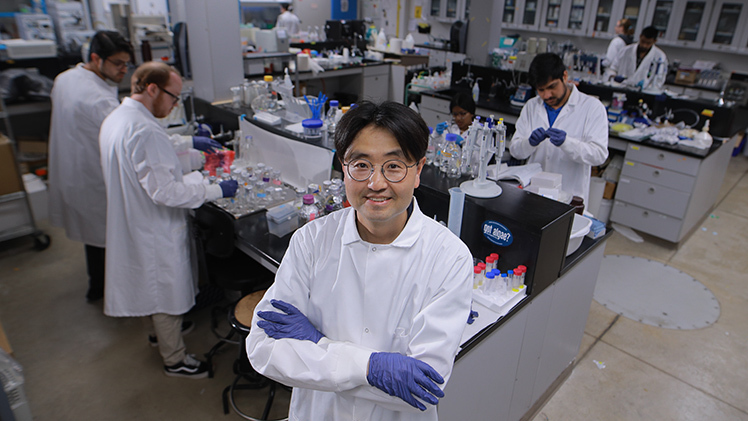Water treatment plant operators see chemical algaecides as an important tool to mitigate the threat of harmful algal blooms, rapid growths of cyanobacteria that can produce toxins that are harmful to people, pets and the environment.
But they’re also aware that when introducing an algaecide, there’s a fine line between helping and harming.

Dr. Youngwoo Seo is a professor in the Departments of Civil and Environmental Engineering and Chemical Engineering.
“At high dosages algaecides can break down cyanobacterial cells, which in turn release toxins that are more difficult to remove from the raw water supply than intact cells,” said The University of Toledo’s Dr. Youngwoo Seo, a professor in the Departments of Civil and Environmental Engineering and Chemical Engineering and the Peter Hess Faculty Fellow in the College of Engineering. “Water treatment plant operators need to factor in potential unintended impacts when applying algaecides to their reservoirs.”
Seo aims to support water treatment plant operators and managers in this task with recently published research in the peer-reviewed Journal of Environmental Management. Together with Dr. Dae-Wook Kang, an assistant professor in the Department of Civil and Environmental Engineering, and a team of undergraduate and graduate researchers, Seo investigated the release of algal organic matter and cyanotoxins from cyanobacteria samples following the application of four algaecides registered for commercial use by the U.S. Environmental Protection Agency.
Their research is expected to be of interest to water utility operators looking to pinpoint the optimal dose of an algaecide for a given situation.
Seo is well suited to lead this research as an expert in water treatment processes who has lent his insights and analysis to plants across northwest Ohio since the drinking water crisis in Toledo in August, 2014, which catalyzed an initial connection between his team and the Toledo Water Treatment Plant. Among his current collaborations is research into the optimization of granulated activated carbon with utilities in Bowling Green and Defiance supported by the Ohio Water Development Authority.
Water quality is a broader area of research excellence at UToledo, whose Water Task Force was recognized with the Association of Public and Land-grant Universities’ Public Impact Research Award in 2022.
In his recent research in the Journal of Environmental Management, Seo considers the circumstances faced by inland water treatment plant operators who draw raw water from reservoirs.
Reservoirs are an effective method to cut down on the fluctuations in water quality that are typical of inland water sources like rivers, which can become turbid and murky after a rainstorm and contain different pollutants. But reservoirs are also stagnant water sources that, as a result, are prone to algal blooms.
Operators can use algaecides to rapidly mitigate blooms by disrupting cell processes and ultimately killing the cyanobacteria. Under some circumstances algaecides trigger lysis, a process by which the cell breaks down and release algal organic matter and cyanotoxins that need to be removed by non-conventional, advanced water treatment processes.
Seo and his research team explored these intended and unintended effects of algaecides in their research, which focuses on two copper-based and two hydrogen peroxide-based algaecides that have previously been found to be safe and effective in the mitigation of cyanobacterial harmful algal blooms.
They applied varying concentrations of the chemical formulations to both unialgal samples sourced from a culture collection and mixed cyanobacterial samples sourced from a bloom in the western basin of Lake Erie in 2022, and at regular intervals documented changes in algal organic matter and cyanotoxins of each sample. They also evaluated simple monitoring methods for water treatment plants to track the release of algal organic matter.
The experiments allowed them to quantify how quickly cells break down and how much organic matter and cyanotoxins they release following the application of each algaecide under different water quality conditions — information that can be vital to operators looking to optimize their mitigation strategies.
“It’s important to understand their uses and limitations of algaecides, particularly in regard to a water treatment plant’s ability to remove algal organic matter from the raw water supply,” Seo said. “Operators can now use our research to help determine the appropriate formulation and concentrations of algaecide for their circumstances.”